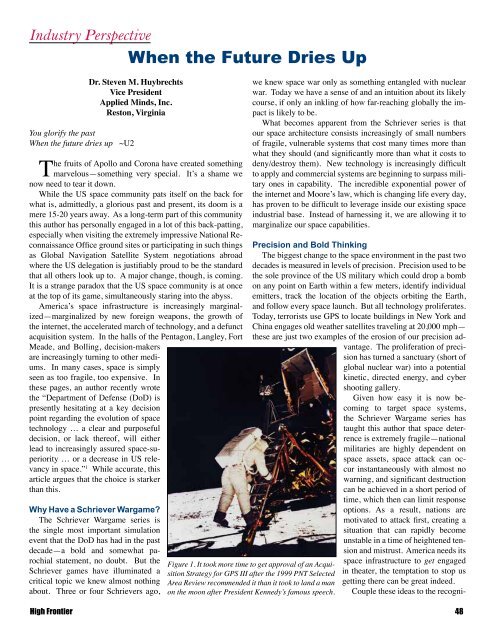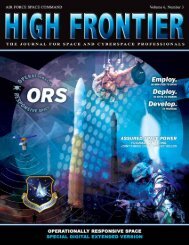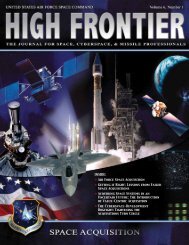Schriever Wargame 2010 - Air Force Space Command
Schriever Wargame 2010 - Air Force Space Command
Schriever Wargame 2010 - Air Force Space Command
- No tags were found...
Create successful ePaper yourself
Turn your PDF publications into a flip-book with our unique Google optimized e-Paper software.
Industry Perspective<br />
When the Future Dries Up<br />
Dr. Steven M. Huybrechts<br />
Vice President<br />
Applied Minds, Inc.<br />
Reston, Virginia<br />
You glorify the past<br />
When the future dries up ~U2<br />
The fruits of Apollo and Corona have created something<br />
marvelous—something very special. It’s a shame we<br />
now need to tear it down.<br />
While the US space community pats itself on the back for<br />
what is, admittedly, a glorious past and present, its doom is a<br />
mere 15-20 years away. As a long-term part of this community<br />
this author has personally engaged in a lot of this back-patting,<br />
especially when visiting the extremely impressive National Reconnaissance<br />
Office ground sites or participating in such things<br />
as Global Navigation Satellite System negotiations abroad<br />
where the US delegation is justifiably proud to be the standard<br />
that all others look up to. A major change, though, is coming.<br />
It is a strange paradox that the US space community is at once<br />
at the top of its game, simultaneously staring into the abyss.<br />
America’s space infrastructure is increasingly marginalized—marginalized<br />
by new foreign weapons, the growth of<br />
the internet, the accelerated march of technology, and a defunct<br />
acquisition system. In the halls of the Pentagon, Langley, Fort<br />
Meade, and Bolling, decision-makers<br />
are increasingly turning to other mediums.<br />
In many cases, space is simply<br />
seen as too fragile, too expensive. In<br />
these pages, an author recently wrote<br />
the “Department of Defense (DoD) is<br />
presently hesitating at a key decision<br />
point regarding the evolution of space<br />
technology … a clear and purposeful<br />
decision, or lack thereof, will either<br />
lead to increasingly assured space-superiority<br />
… or a decrease in US relevancy<br />
in space.” 1 While accurate, this<br />
article argues that the choice is starker<br />
than this.<br />
Why Have a <strong>Schriever</strong> <strong>Wargame</strong><br />
The <strong>Schriever</strong> <strong>Wargame</strong> series is<br />
the single most important simulation<br />
event that the DoD has had in the past<br />
decade—a bold and somewhat parochial<br />
statement, no doubt. But the<br />
<strong>Schriever</strong> games have illuminated a<br />
critical topic we knew almost nothing<br />
about. Three or four <strong>Schriever</strong>s ago,<br />
we knew space war only as something entangled with nuclear<br />
war. Today we have a sense of and an intuition about its likely<br />
course, if only an inkling of how far-reaching globally the impact<br />
is likely to be.<br />
What becomes apparent from the <strong>Schriever</strong> series is that<br />
our space architecture consists increasingly of small numbers<br />
of fragile, vulnerable systems that cost many times more than<br />
what they should (and significantly more than what it costs to<br />
deny/destroy them). New technology is increasingly difficult<br />
to apply and commercial systems are beginning to surpass military<br />
ones in capability. The incredible exponential power of<br />
the internet and Moore’s law, which is changing life every day,<br />
has proven to be difficult to leverage inside our existing space<br />
industrial base. Instead of harnessing it, we are allowing it to<br />
marginalize our space capabilities.<br />
Precision and Bold Thinking<br />
The biggest change to the space environment in the past two<br />
decades is measured in levels of precision. Precision used to be<br />
the sole province of the US military which could drop a bomb<br />
on any point on Earth within a few meters, identify individual<br />
emitters, track the location of the objects orbiting the Earth,<br />
and follow every space launch. But all technology proliferates.<br />
Today, terrorists use GPS to locate buildings in New York and<br />
China engages old weather satellites traveling at 20,000 mph—<br />
these are just two examples of the erosion of our precision advantage.<br />
The proliferation of precision<br />
has turned a sanctuary (short of<br />
global nuclear war) into a potential<br />
kinetic, directed energy, and cyber<br />
shooting gallery.<br />
Given how easy it is now becoming<br />
to target space systems,<br />
the <strong>Schriever</strong> <strong>Wargame</strong> series has<br />
taught this author that space deterrence<br />
is extremely fragile—national<br />
militaries are highly dependent on<br />
space assets, space attack can occur<br />
instantaneously with almost no<br />
warning, and significant destruction<br />
can be achieved in a short period of<br />
time, which then can limit response<br />
options. As a result, nations are<br />
motivated to attack first, creating a<br />
situation that can rapidly become<br />
unstable in a time of heightened tension<br />
and mistrust. America needs its<br />
Figure 1. It took more time to get approval of an Acquisition<br />
Strategy for GPS III after the 1999 PNT Selected<br />
Area Review recommended it than it took to land a man<br />
on the moon after President Kennedy’s famous speech.<br />
space infrastructure to get engaged<br />
in theater, the temptation to stop us<br />
getting there can be great indeed.<br />
Couple these ideas to the recogni-<br />
High Frontier 48











